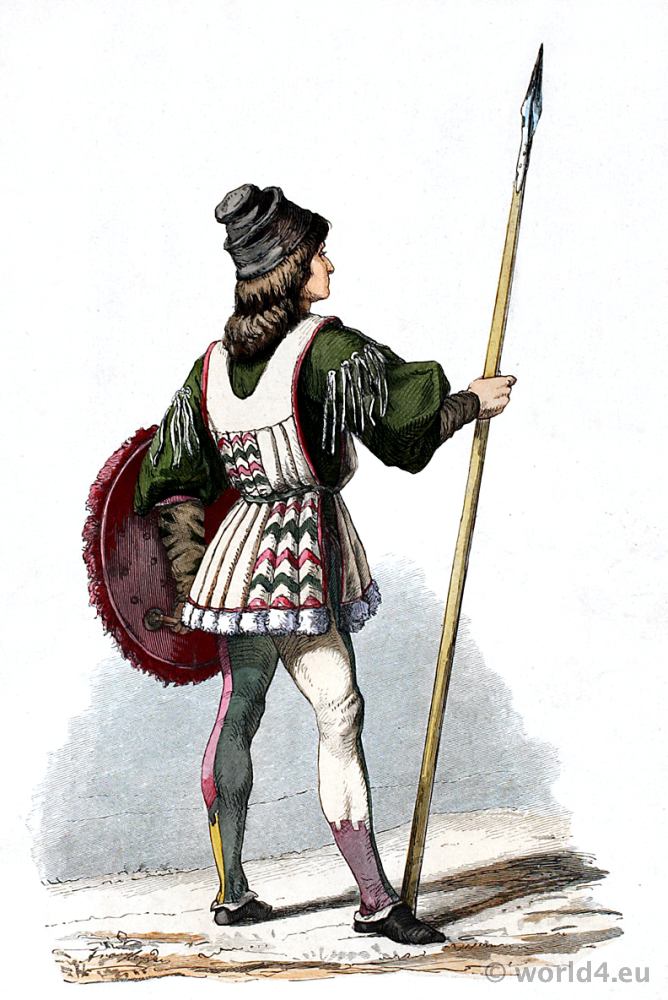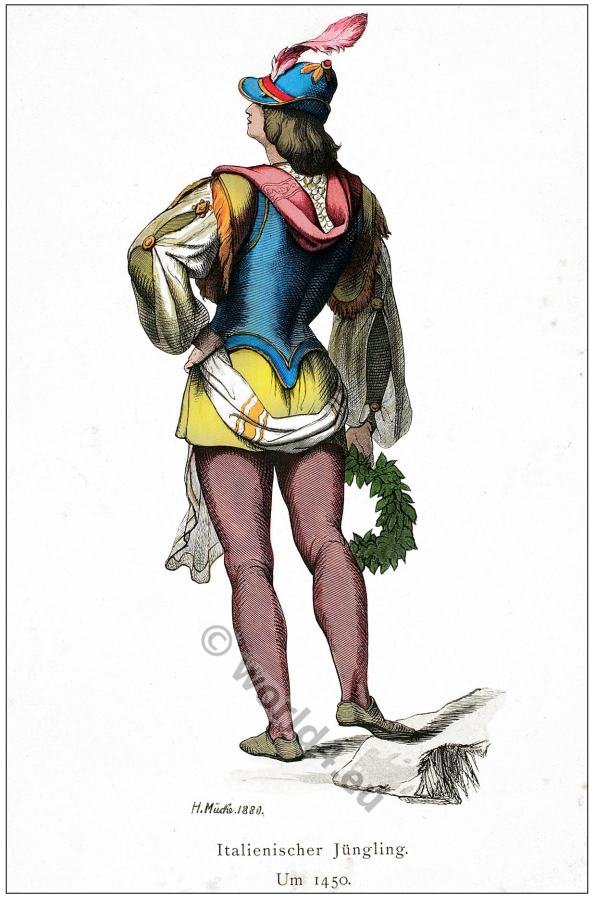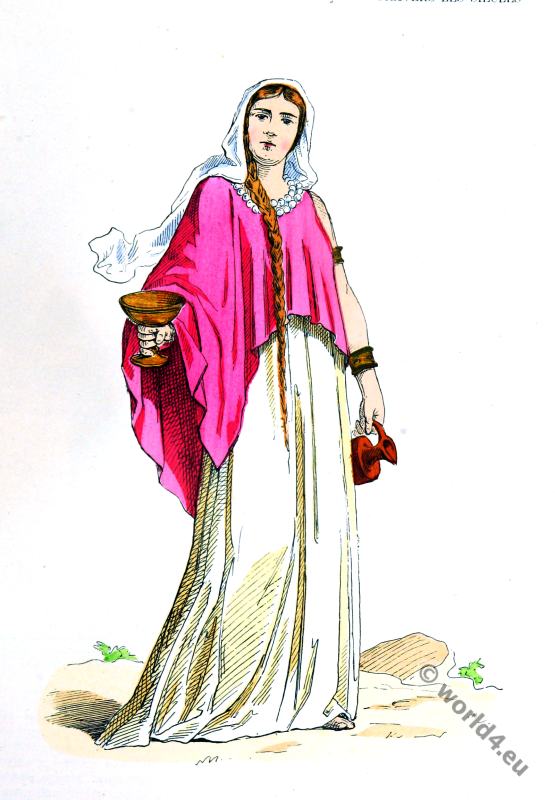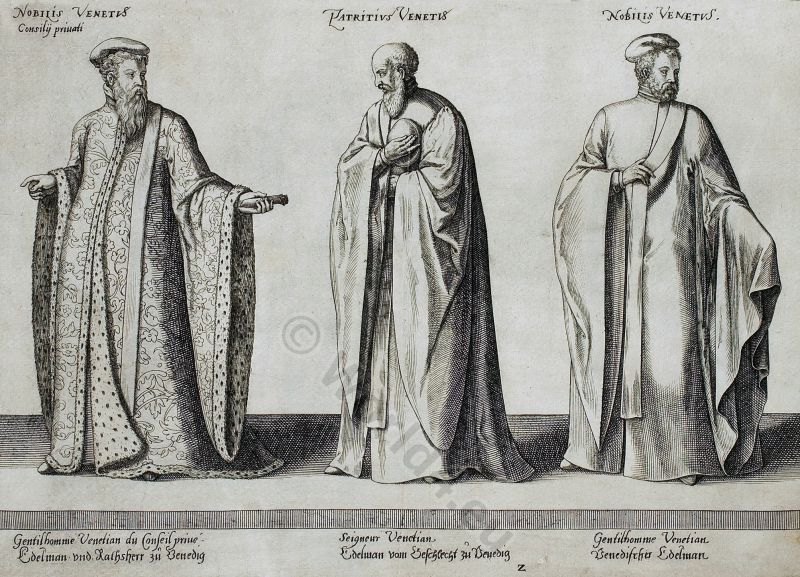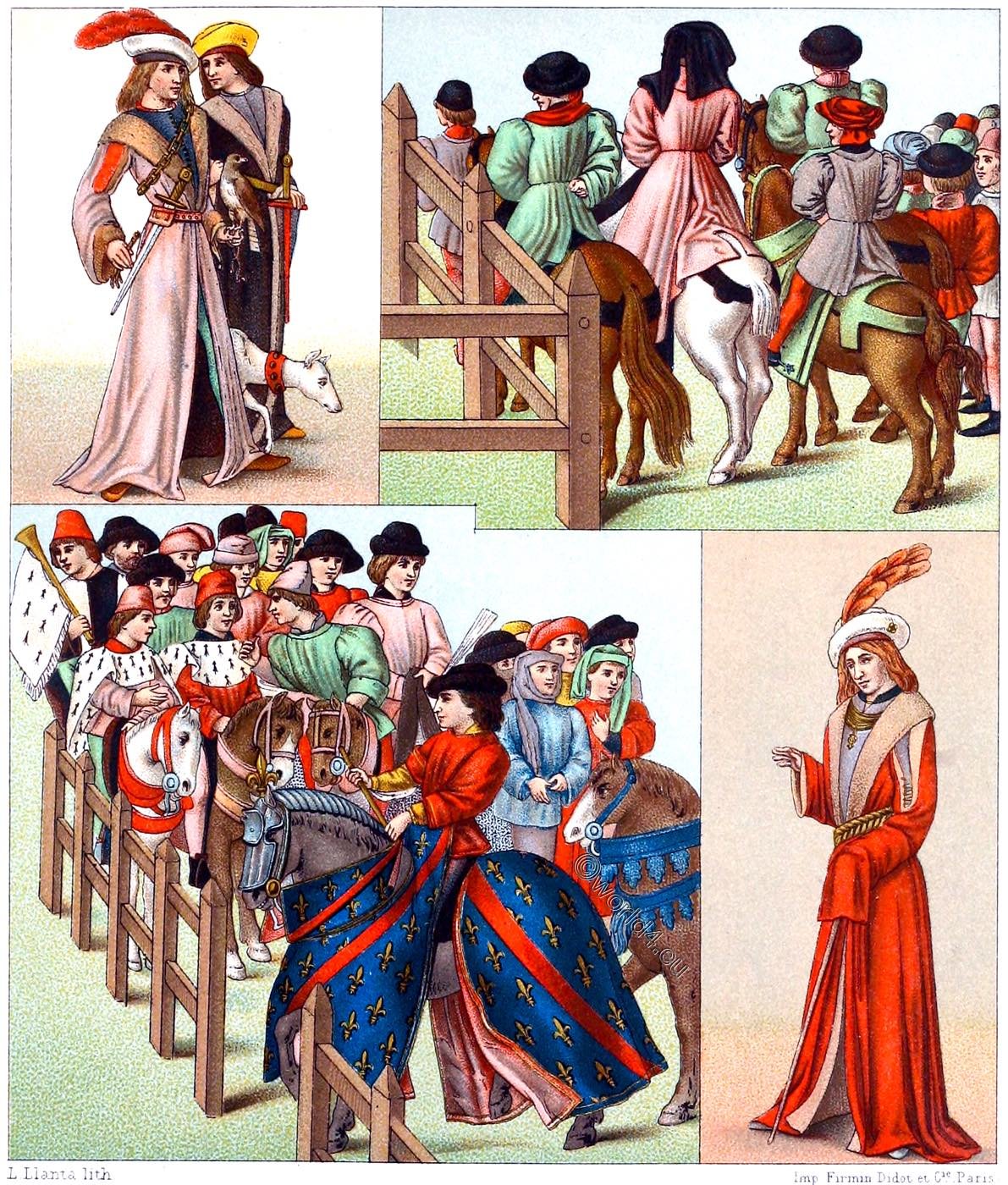A YOUNG VENETIAN OF THE SOCIETY DE LA CALZA.
by Henry Hinton.
The Society of La Calza. Compagnia della Calza.
The Society of La Calza was an association of young Venetian noblemen and a few strangers of high rank, who, with the sanction of the magistrates, bound themselves by the ties of procal friendship, and had for their object the pursuit of honorable pleasures.
They gave, at their own expense, public fetes, accompanied with theatrical representations. They met together to discourse music, to hold gondola races, to celebrate masquerades, and for every kind of innocent amusement. In order to recognize each other in the public fetes, they wore the right stocking ornamented with various colors, and even with embroideries of gold, of silver, or of pearls.
The young man of this Society whom our plate represents is drawn and colored after a picture of Vittore Carpaccio (1465-1525/26), preserved in the Academy of Fine Arts at Venice. The bonnet is of violet velvet, enriched with golden embroideries and ornaments; the jacket is of green velvet, with a narrow red border below; the doublet is black, and permits the shirt to be seen; the left stocking is adorned with white and black stripes; the right stocking is scarlet, ornamented with two palm branches, and with an embroidery of pearls upon the thigh; the gloves are yellow.
Source: Select historical costumes compiled from the most reliable sources by Henry Hinton. Published: 1868. Publisher: New York Wynkoop & Sherwood.
The Society De la Calza
The society De la Calza (of the stocking) was formed in Venice in the year 1400 to the honor of inauguration of the doge Michele Steno (around 1331-1413). The employments of the members were conversation and festivity; and so splendid were the entertainments of music and dancing, that the gay spirits of other parts of Italy anxiously solicited the honor of seats in the society.
All their statutes regarded only the ceremonies of the ball or the theatre; and the members being resolved on their rigorous performance, took an oath in a church to that tendency. They had banners and a seal like an authorized order of knighthood. Their dress was as splendid and elegant as Venetian luxury a taste could fashion it; and consistent with the singular Italian custom of marking their academies and other intellectual associations by some external signs of folly, the members when they met in literary discussion were distinguished by the colors of their stocking.
The colors were sometimes fantastically blended; and at other times one color, particularly the blue prevailed. The society De la Calza lasted till the year 1590 when the foppery of Italian literature took some other symbol. The rejected title then crossed the Alps and found a congenial soil in the flippancy and literary triflings of Parisian society, and particularly branded female pedantry, as the strongest feature in the character of French pretension.
It diverged from France to England and for a while marked the vanity of the small advances in literature of the female coteries; but the propriety of its application is now gradually ceasing; for we see in every circle that attainments in literature can be accomplished with no loss of womanly modesty.
It is in this country, above all others that knowledge asserts her right of general dominion, or contends, that, if she be the sustaining energy of one sex, she forms the lighter charm the graceful drapery of the other.
Source: La Belle Assemblée: or, Bell’s Court and Fashionable Magazine. British women’s magazine published from 1806 to 1837, founded by John Bell (1745–1831).
COMPAGNIA DELLA CALZA.
The life and works of Vittorio Carpaccio.
This Company was originally an association of gentlemen, banded together with the object of organizing festivities of all kinds. Membership was not restricted to Venetians, for foreigners were also admitted, and even ladies, who were styled “companions” (compagne), and wore the badge of the “Company” upon their sleeve. The Company was later on sub-divided into groups each under its own head and distinguished by some particular name, such as Immortali, Semprevivi, Perpetui, Eterni Pavoni, Ortolani, Giardinieri, Felici, etc.
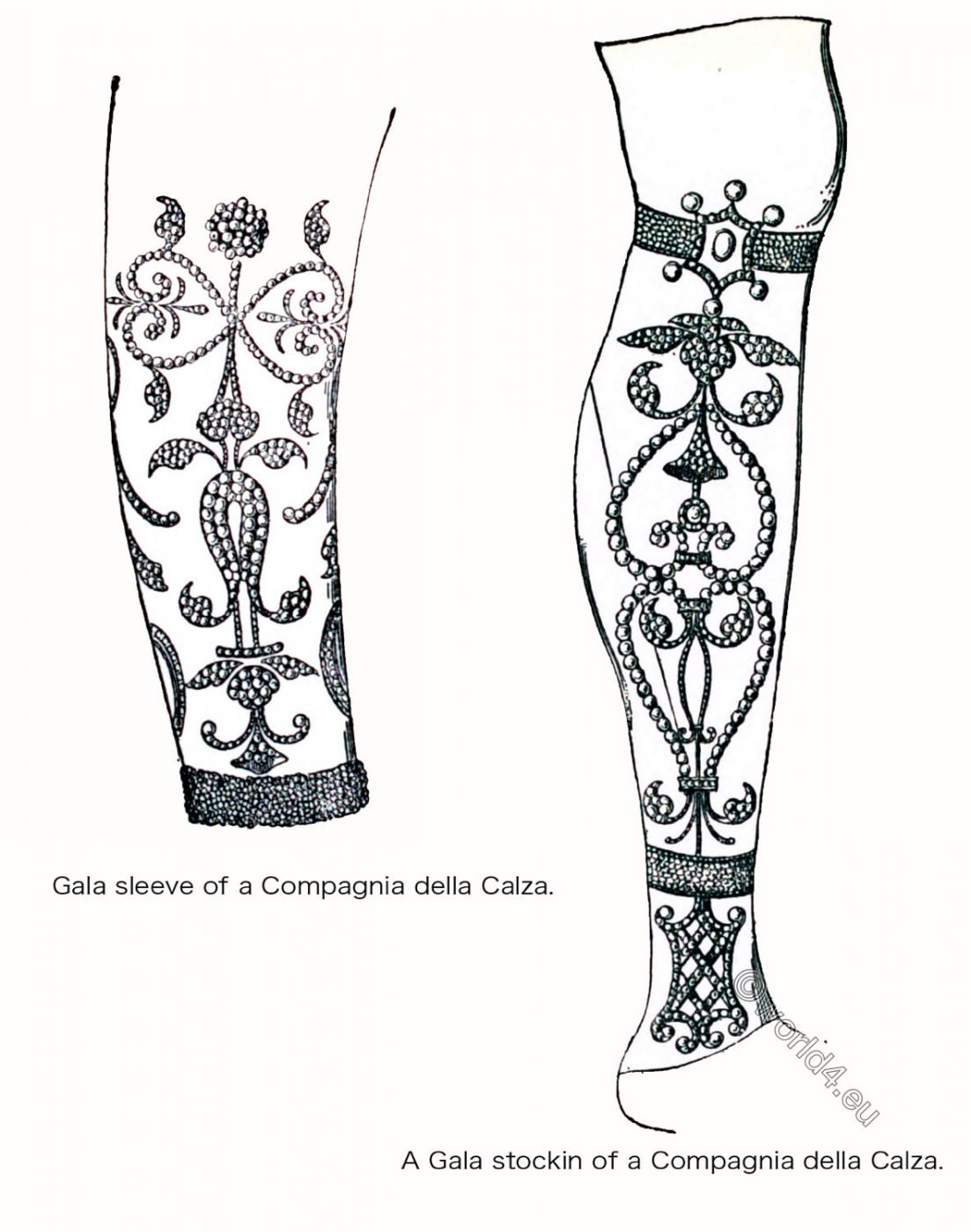
In Carpaccio’s paintings the Companions of the Calza the arbiters of Venetian fashion, wore doublets of gold-embroidered velvet and silk, drawn into the figure by a girdle. Their sleeves were slashed and fastened with points to show the full shirt underneath. The upper part of their close-fitting hose was striped in many colors, and their shoes were pierced in quaint devices.
The Companions of the Calza wore besides over their shoulders a short cloak and a hood of cloth of gold or damask, embroidered on the back with the particular emblem of their Company. These badges were usually richly worked in pearls, as we may notice in this third scene upon the person of the Ambassador.
Likewise in the first scene, The English Ambassadors before King Maurus, we may observe near the King’s throne a cavalier wearing a badge upon his sleeve, of which emblem we give here a separate illustration.
- What does this ornament signify?
- To which of the Calza Companies does it belong?
It represents an interlaced hurdle of osiers. Now the science of Heraldry and a comparison with other symbolical pictures show us that these hurdles signify a “garden.” Thus in Giovanni Boccatis’ picture at Perugia of Christ in the Garden of Olives the garden is represented by a thick hurdle of osiers; and a similar hurdle with the same signification recurs in a miniature quoted by Silvestre, and preserved in the Bibliotheque Nationale in Paris, wherein S. Catherine of Siena receives the Stigmata in a garden.
But this is not all. In the library at Bergamo, in a book of patterns for embroideries dating from the end of the fourteenth century, is to be found among other designs a swan in a garden; and the garden consists of a species of crate or basket of osiers.
A similar hedge also indicates a garden, with a white stag in the middle, in the escutcheon of King Richard II. of England, sculptured upon the tomb of Thomas Mowbray, Duke of Norfolk. This tomb in Carpaccio’s time stood in the forecourt of S. Mark’s. It was removed to England, and in a very ruinous state is now in the possession of the Duke’s descendants.
The emblem however in Carpaccio’s painting exhibits greater similarity with the “canting” (parlante) coat-of-arms belonging to the Veronese family of Orti. We may conclude therefore that the badge worked upon the Cavalier’s sleeve was that of the Company of the Ortolani. This theory finds confirmation in the analogy of this costume with the description in a document of Cicogna’s in the Museo Civico, whence we learn that the Company of the Ortolani did not, like the other Companies, wear parti-colored hose, but carried their badge embroidered upon one of their sleeves.
These badges had great importance in the History of Costume, especially in mediaeval times. For jousts and tournaments cavaliers vied with one another in the invention of the most beautiful or original emblems. They sought advice from the men most learn cd and competent in the matter, and an entire literature on thc subject came into being, lasting to the end of the eighteenth century.
It will suffice to record among the most important works Torquato Tasso’s Dialogue of Devices (Dialogo delle imprese). Monsignor Giulio Giovio, Bishop of Nocera, in his Dialogue on Military Devices (Dialogo delle imprese militari) devised as an emblem for a Genoese patrician, Girolamo Andorno, Jove’s Thunder-bolt copied from an antique medallion, with the motto: “He will expiate or overwhelm” (Expiabit aut obruet). This badge, much lauded by Andrea Navagero, was designed and colored by Titian, and magnificently embroidered by the able Venetian, Agnolo di Madonna.
Source: The life and works of Vittorio Carpaccio by Pompeo Molmenti and Gustav Ludwig. London: Murray 1907.
Related
Discover more from World4 Costume Culture History
Subscribe to get the latest posts sent to your email.





